PROSTATE ROBOTIC SURGERY

How Effective is Prostate Robotic Surgery (also known as Prostatectomy)?
A prostatectomy is a major operation that typically takes several hours. It involves making a 4″ incision in the lower abdomen to surgically remove the prostate gland. Hospitalization is required for a few days, and a catheter in the bladder needs to be used in all patients for a few weeks following the procedure.
Robotic prostatectomy can be done at select institutions. The surgeon guides robotic arms to help perform the operation. Smaller incisions are used, which may result in slightly shorter recovery times. Several studies have, however shown a higher risk of positive margins (leaving cancer behind) following robotic surgery requiring supplemental treatment afterward. (JCO 2008)
A recent major study from Harvard showed that men who underwent robotic surgery actually had higher rates of incontinence (loss of urinary control) and loss of sexual function (impotence) than men treated with an open prostatectomy (JAMA 2009) (Eur Urol 2010).
Additional studies have shown that outcomes following robotic surgery are significantly worse if the surgeon has performed less than 250 of these procedures. (JNCI 2007) (NEJM 2002). The proliferation of robotic surgery is controversial at best, as it has NOT been shown to improve long-term outcomes compared with traditional surgery. NY TIMES
A prostatectomy can only cure men when the cancer is completely removed. As is often the case, if surgery leaves behind even a few microscopic cancer cells, these can later grow and ultimately spread, leading to painful metastasis and even death.
Results for robotic or open surgery vary based on cancer-specific risk factors. Surgery outcomes with selected risk factors can be seen in the table below. These results are based on the largest series published for surgery. As mentioned above, curative outcomes do not improve with robotic surgery compared to traditional open prostatectomy. (Walz et al BJUI 2010)
Why is Radiation Frequently Needed After Surgery (Post-Prostatectomy Radiation)?
Depending on their stage of disease at diagnosis, up to 40% of men who undergo prostatectomy will either have some cancer left behind (positive margins) or have disease spread beyond the prostate (extra-capsular disease).
Several recent studies have shown that giving radiation to the prostate area following surgery has significantly improved the likelihood of long-term cure without significantly increasing the side effects caused by the prostatectomy.
ASK THE DOCTOR
CLICK HERE
TREATMENT HOURS
Mon: 6:30am – 5:30pm
Tues: 6:30am – 5:30pm
Wed: 6:30am – 5:30pm
Thurs: 6:30am – 5:30pm
Fri: 6:30am – 5:30pm
Sat: CLOSED
Sun: CLOSED
TREATMENT OPTIONS
PAGE: Print | PDF | Email
Salvage Therapy
We can often succeed where others have already failed. We have successfully salvaged men that have recurred after prior proton therapy, surgery, cryotherapy and HIFU. Salvage therapy requires very special expertise in order to be done in a safe and effective manner. We have the largest published series in the world performing salvage prostate seed implants.
Long-Term Outcomes with Prostate Surgery
10-year SUCCESS RATES: 80%
10-year SUCCESS RATES: 55%
10-year SUCCESS RATES: 37%
10-year SUCCESS RATES: 36%
EXPERT & EXPERIENCED: TALK TO A PROSTATE CANCER TREATMENT EXPERT
Get a second opinion on your prostate cancer treatment options from Florida Center For Prostate Care, your prostate cancer treatment experts.